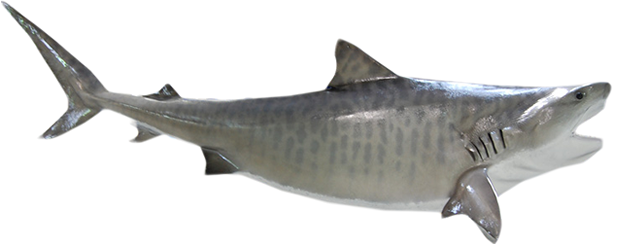Shark, Tiger

View Regulations

Scientific Name
Galeocerdo cuvier


Common Names
Leopard shark


Description
Tiger Sharks take their name from their juvenile appearance, that often involves patterns of stripes or spots on their body, as they age these spots fade. Their coloration includes the brownish spots or stripes and the rest of their body can range from grey-blue to grey-brown. The first two gill slots are above their pectoral fin with the other three following. They are equipped with blunt rounded snout that hides a mouth full of broader, somewhat serrated teeth that appear similar in both the upper and lower jaw.


Habitat & Behaviour
Tiger Sharks are night time hunters that come into coastal waters during the dark to hunt for prey and rest in deeper waters during the day. They prefer areas that are along shelves although they can be found in many areas despite this. Often they can be found close in to shore near the mouths of rivers or in lagoons and reefs.


Natural Prey
Tiger Sharks have a broad diet and attack targets of opportunity, whether it be garbage, other sharks or fish. If it’s in the water they will eat it.


Handling Tips
It goes without saying that you should steer well clear of any sharks mouth. They also have rough skin which if whipped on you can leave a rash. Little ones wiggle a quite a bit, grab behind gills and hold tail. Larger sharks tail snare if you can and keep in water. When releasing sharks try to leave as little line as possible. Hooks rot out in a few weeks. Pro Angler supports shark conservation and recommends you catch and release. If brought into the boat, leave for 15-20 minutes before handling, shark will tire and be easier to handle as their body is very strong as well. Known to even play dead before snapping at you, so be careful!

- Lucky Tackle Box
- Billfish Bounty in the Heart of the Mayan World – Guatemala
- The Best Species of Shark to Catch
- How to Catch a Shark: what equipment do you need?
- The Best Winter Fishing Spots in Texas





